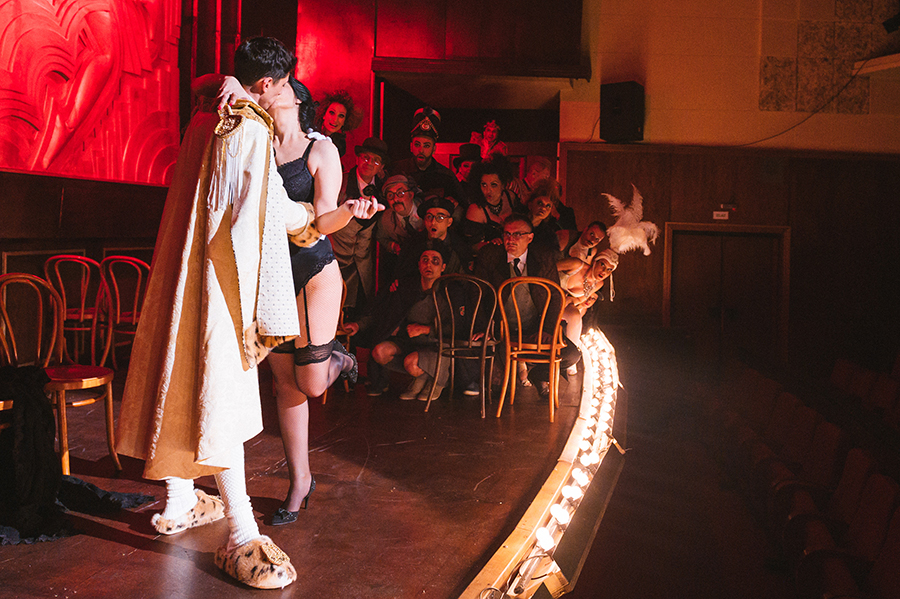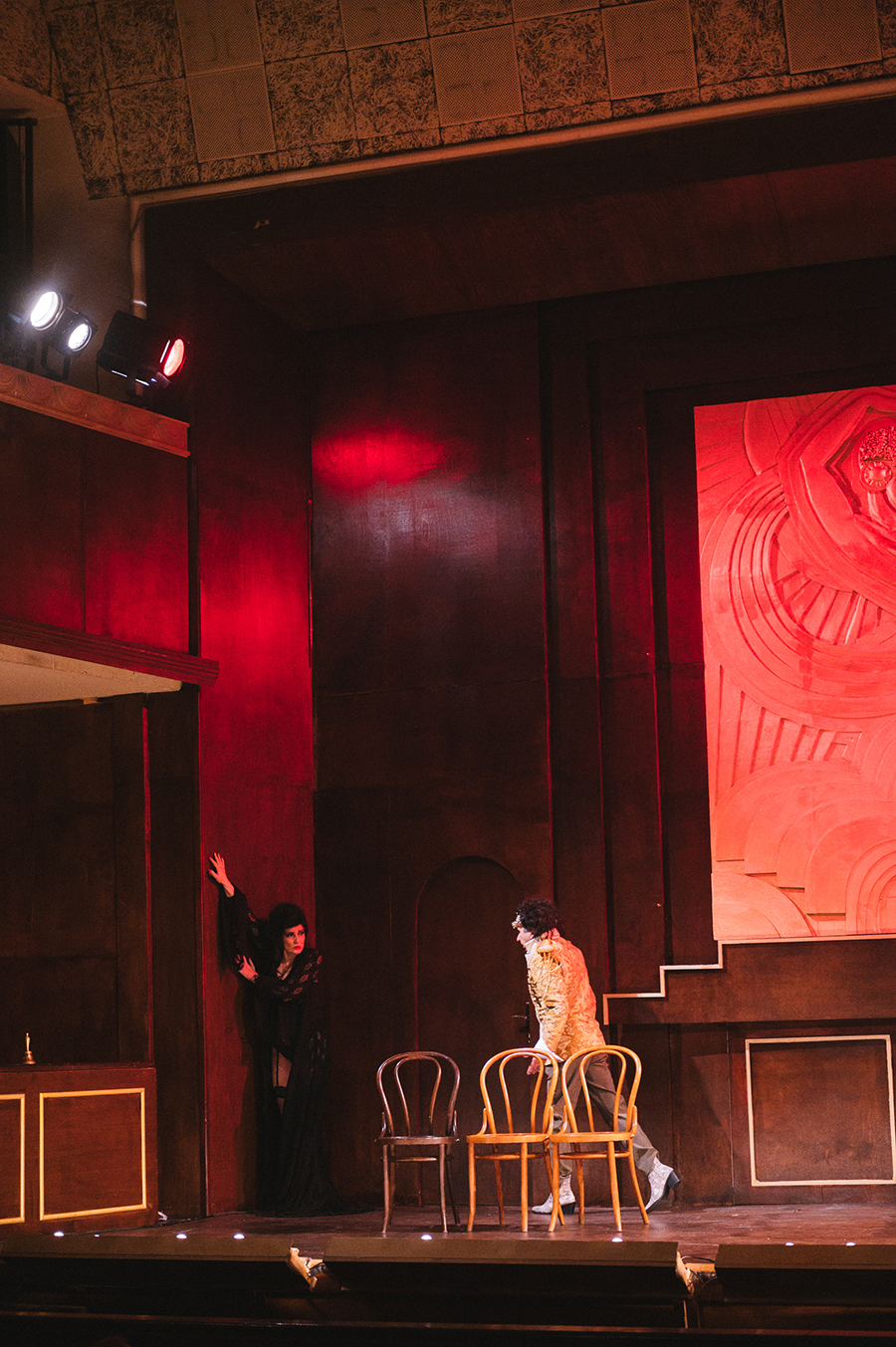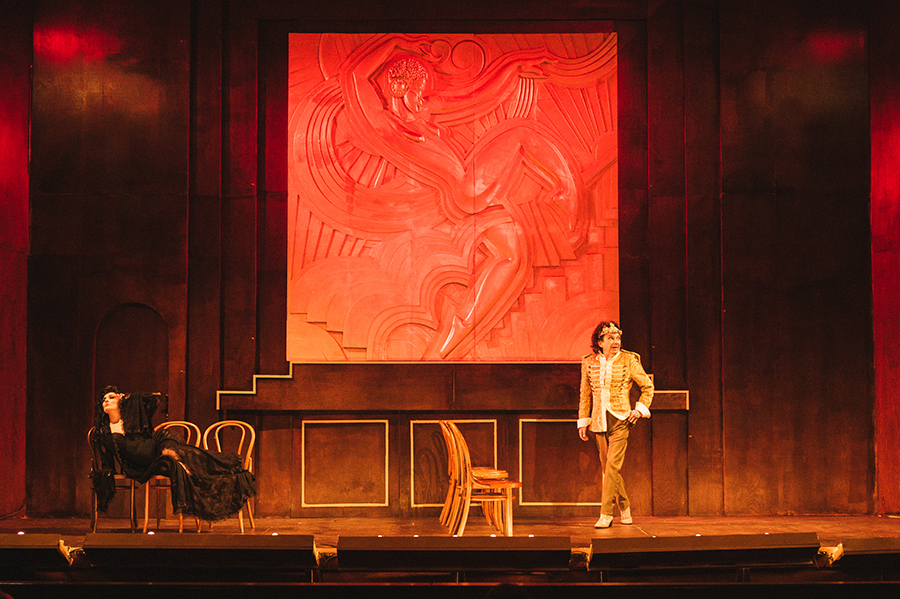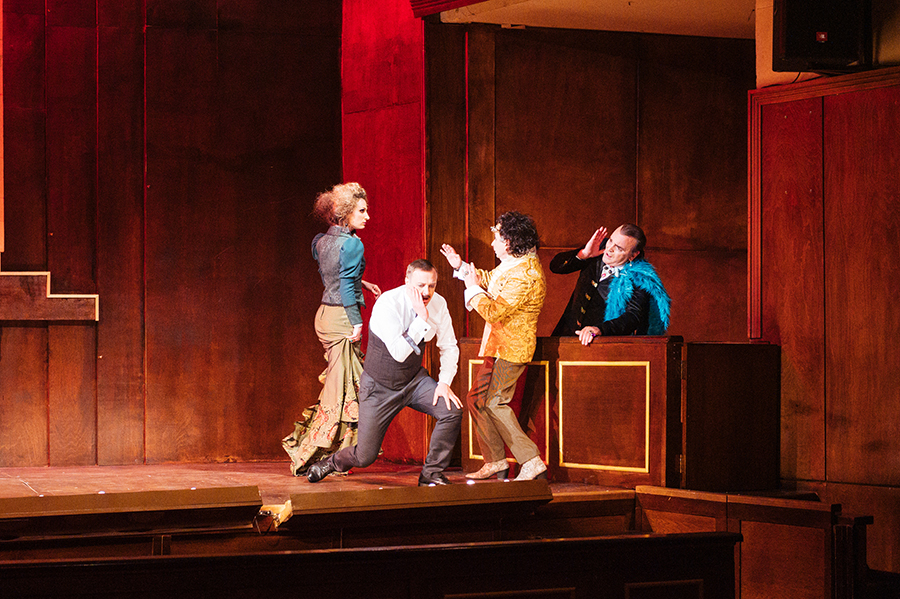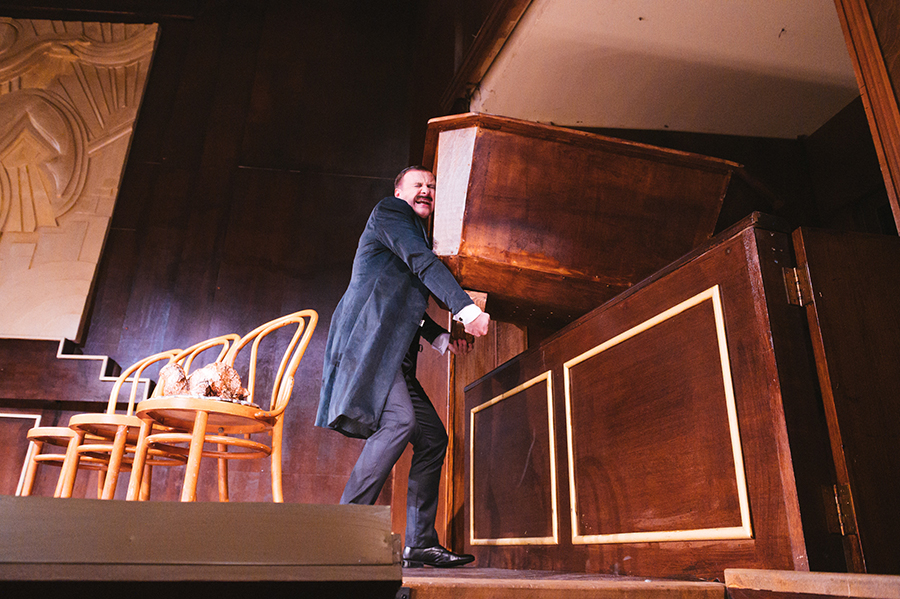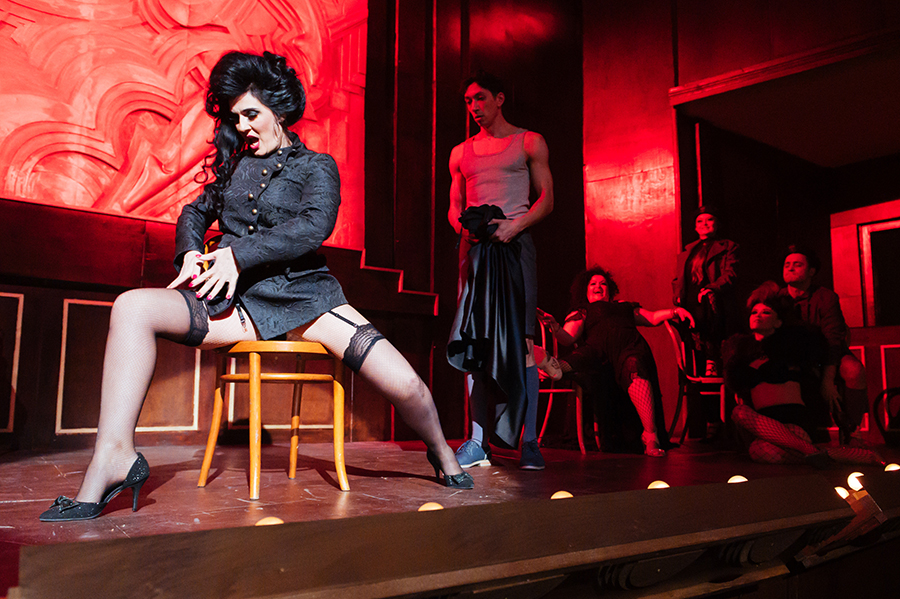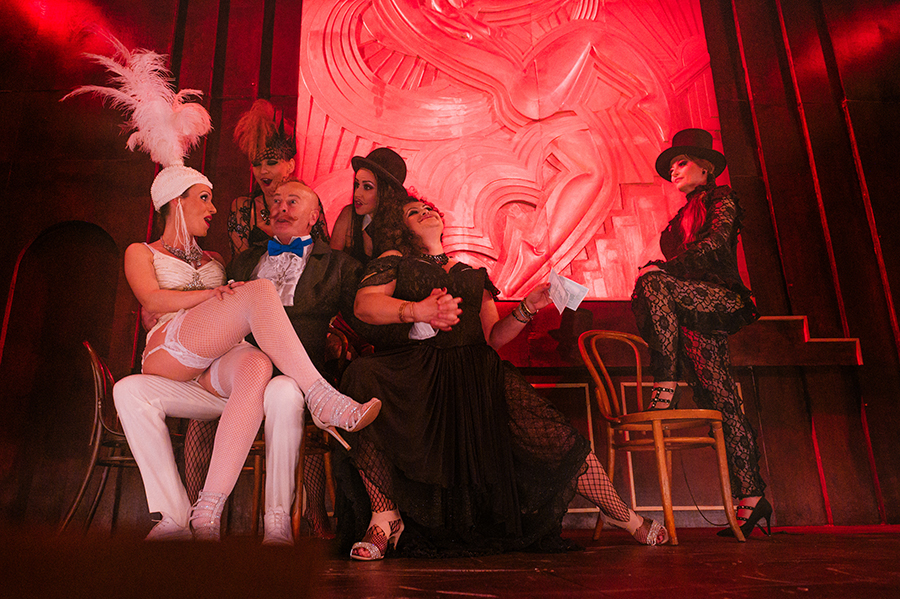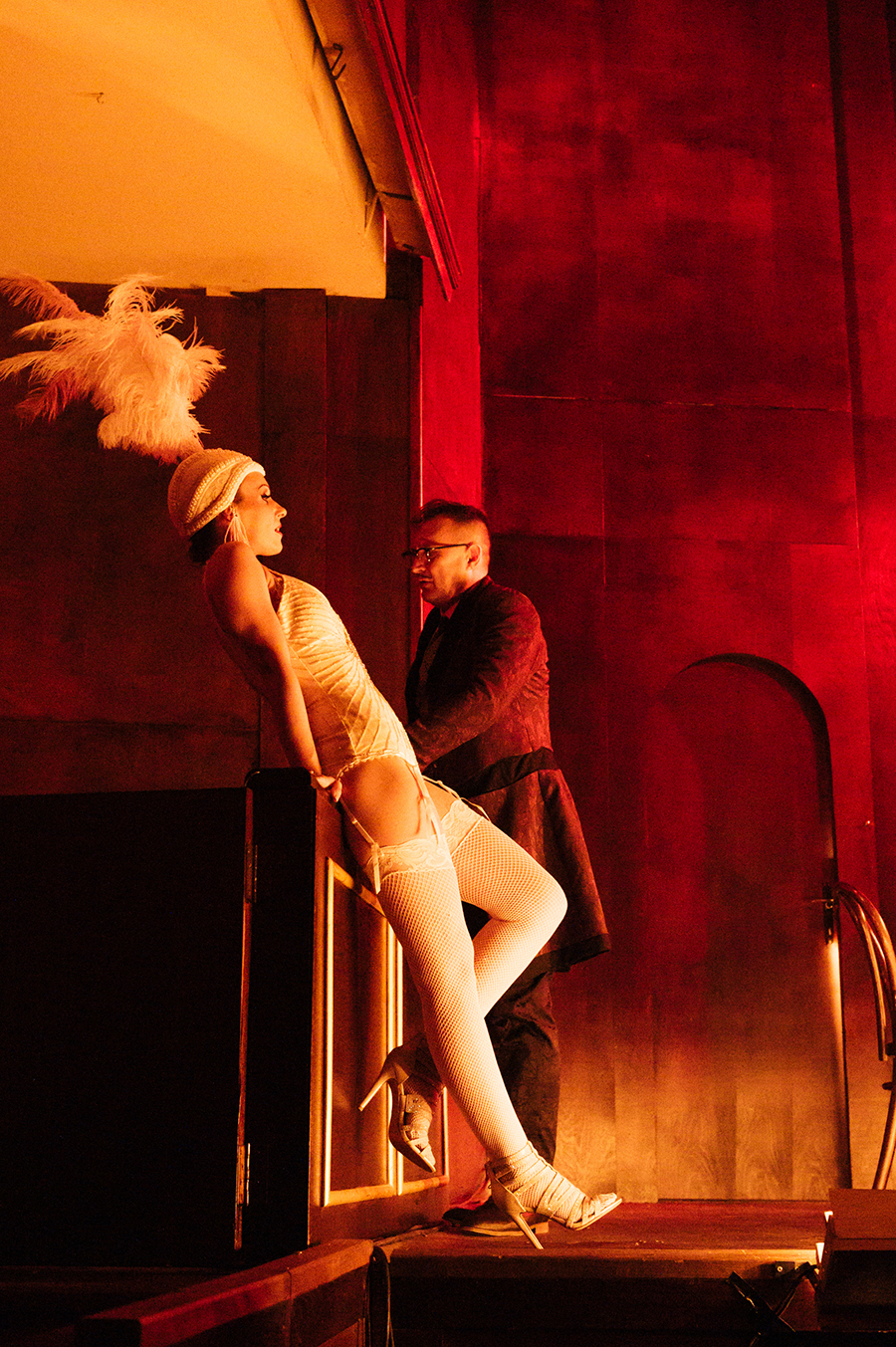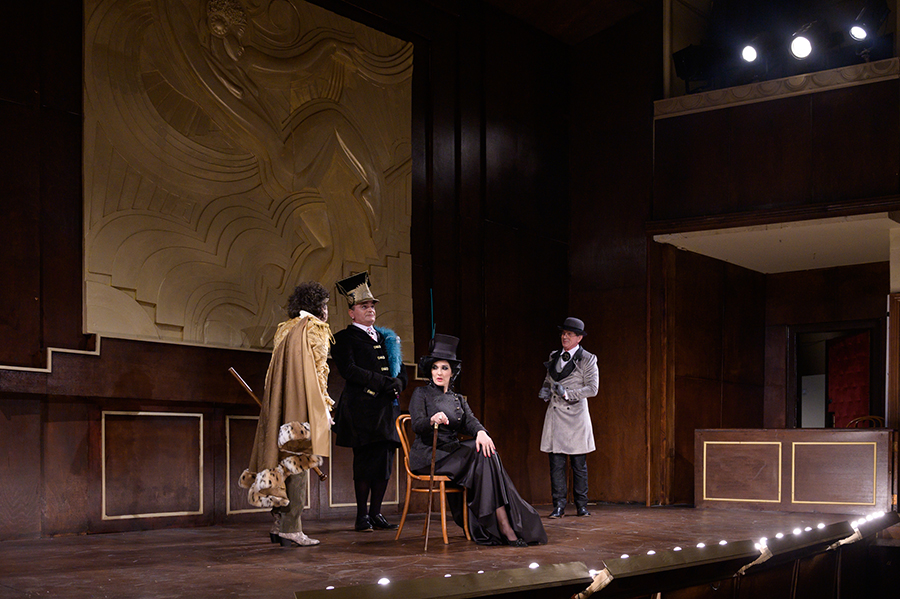
The Duchess of the Folies Bergeres
The hilarious comedy of the famous George Feydeau will easily draw the audience into a witty story full of incredible twists and unexpected plots. The adventures of the charming and sly Parisian beauty who with a turn of the fate becomes a duchess, but fails to resist the call of her past life, and her naïve and blinded cuckold husband, will have the audience laughing tears and keep them entertained.
Jug Radivojević was born on March 1st, 1972 in Belgrade.
He finished elementary and high school in Vranje. He began his career in the theatre “Bora Stanković” in Vranje, with his father a theatre manager, stage director and actor, and his mother an actress. He graduated from the FDA in Belgrade with the play “Koštana” by Bora Stanković (JDP, Belgrade). So far, he has directed over 100 plays in theatres in Serbia and the region. He has won over 50 most important awards in the country and abroad. He is engaged in film and TV directing. He was the full-time stage director of JDP and assistant professor at the FDA in Belgrade, the Department of Drama. He is now a full-time drama director of the National Theatre in Belgrade. He is the President of the BITEF Committee. He is a member of the FC Red Star Board and a president of Red Star Foundation. He has been the SDPS vice President since its foundation. He is married to actress Milena Vasić and a father of two sons, Vuk and Lav.
The writing career of Georges Feydeau (1862, Paris), “the King of Vaudeville” began with drama monologues, and it was at the age of twenty that he already wrote his first play Through the Window. His first huge theatre success was the play Ladies’ Dressmaker, which he wrote at the age of twenty-four. He found huge success in 1892 with the plays Mr. Hunter and Champignol (In Spite of Himself). Since that time, Feydeau had success after success: Free Exchange Hotel/Paradise hotel, Sauce for the Goose, An Absolute Turkey, The Girl from Maxim’s, A Flea in Her Ear, Keep an Eye on Amelia, Don’t Walk around Naked. His plays have been staged all around the world with huge success. He died in 1921 and was buried in Montmartre cemetery.
Henry Gidel
FEYDEAU AND THE THEATRE OF THE ABSURD*
…Ever since 1938, Paul Hazard has greeted Feydeau as the inspirer of the absurd (loufoque) in theatre and film. The farce that Robert Kemp sees in the play “The Girl from Maxim’s” will not be outdone by the inventiveness of the “Parade”, “The Eiffel Tower Newlyweds”, or “Breasts of Tiresias” For others, “Feydeau’s work is a source of the Dada Theatre”. As early as 1930, Antonin Artaud himself mentioned Feydeau among those who influenced the Alfred Jarry Theatre (which he founded together with Roger Vitrac). After World War II, the orientation towards surrealism and avant-garde of the thirties took hold, and then even more towards the Theatre of the Absurd of the fifties, towards Ionesco in particular. This is the case, for example, with Henry Janson and Bertrand Poirot-Delpech, as well as one of the co-authors of a recently-published history of contemporary literature. Ionesco admits there is a “great resemblance” between Feydeau’s work and his own. Indeed, there are a number of analogies between Feydeau’s and the Theatre of the Absurd. The first one is found in what constitutes the basic philosophical starting point of one and the other: in both cases, the human situation is seen essentially pessimistic; a man is often an ordinary puppet, a toy of immense circumstances and stupid fatalities. There is no particular belief or ideal to guide and comfort him. All his efforts, foredoom to failure, prove to be completely futile. Let us remember how at the end of Beckett’s “Waiting for Godot” protagonists are in absolutely the same position as at the beginning of the play; isn’t that the case with most of Feydeau’s characters, the eternal jokes of the same farce? Likewise, those poor couples we encounter at Beckett’s or Ionesco’s, correspond to families being torn apart by absurd quarrels, from Feydeau’s last one-act plays. Below the surface of cheerfulness that at first glance differs Feydeau’s world from the world of modern theatre, actually, the same lack of illusions, the same scepticism, and the same unrelenting vision of human being is hidden. In addition to the comparisons we have made, some of which are particularly striking, it is clear however that in certain points Feydeau’s work has been deeply rooted in the tradition. Unlike most of the avant-garde playwrights, he adheres to the established drama categories: the time and place in which the story unfolds have been precisely determined; carefully designed action contains the exposition, the plot and the outcome. If the characters are sometimes “made of paper”, the author still places them socially and outlines their contours meticulously. In addition, it is hard to find traces of symbolic or metaphysical ambitions in his writing. His only goal is to cause laughter. Of course, travesty and abandon are frequent with Feydeau, but they do not fall into the very definition of that theatre, as is the case in the New Theatre: Feydeau does not start from the absurd, it comes to him: in his plays, extravagance bounds and decorates the way the audience is firmly guided by. When Ionesco transforms his heroes into rhinoceroses, he does not provide us with any explanation of this bizarreness; but when Feydeau, as we have seen, wants one of his characters to bark or for a horse to appear in his dining room, he will provide us with some reason for it, even if it is lame. He did not invent absurdity, because it was already flourishing on stage at the time he wrote his plays, but he incorporated it into logical mechanisms, whose impeccability we want to emphasize above all in this text. Namely, that is, in fact, where his originality lies; therefore, it is no surprise that his plays at the same time attract audiences inclined to a traditional theatre and those interested in new dramatic flows.
Translated from French
Marina Orlović
Georges Feydeau
DEATH OF VAUDEVILLE AND MELODRAMA
What a joke! Vaudeville is dead! Melodrama is dead! Really! Would you rather join the ideas of this small group of young authors, who did not find a better way to kill these two flourishing genres that bother them, than to simply declare them dead? But think, dear friends, if they were really dead, would it be necessary to invest effort and raise noise about it? When something does not exist anymore, do we feel that great a need to talk about it? Finally, if vaudeville and melodrama were really dead, would they be played four or five hundred times in a row, while a single comedy of the so-called superior genre (as if a classification of genres exists!) is played hardly one hundred times with equal success? How can we explain such advantage of the late genre? Perhaps with a saying “when something is dead, then this is for something else”? In that case, long live death!
No. The truth is that there are vaudeville and vaudeville, melodrama and melodrama, as well as comedy and comedy. When vaudeville is well made, it has logic, the logic above all; it is well connected, it contains observations, characters are not just puppets, the action is interesting and the situations are fun – then it is a success. The same goes for melodrama: go see “Two Children”, and “Lovers of Paris”: what do these plays owe their success to? They owe it to being good melodramas, the first one in particular.
I particularly resent vaudeville and melodrama criticizers for their malice in the struggle they have undertaken. When vaudeville or melodrama fail, you can hear them roaring as they go along: „There, see, the vaudeville is dead! I have told you that melodrama is over! “But why do they instantly become speechless when vaudeville or melodrama succeed? Damn it, what – let’s be loyal opponents! Are we going to benefit from the disaster of this or that comedy– and they definitely do fail– and on the basis of which we will announce that the comedy is dead? Come on, please! We would be too scared that we would be considered imbeciles; do you, therefore, have less concern for public opinion than we do?
What should we say then about these haughty ones that burst with superiority they ascribe to themselves, and who declare with utter contempt how the vaudeville and melodrama “are neither literature nor theatre”? “They are not literature” – let it be! Since the literature is an antithesis of a theatre: the theatre is a picture of life and in life, you do not speak literarily: therefore, just the fact that you will make your characters speak literarily is enough to deprive them of vitality and make them non-existent. But “not theatre” – wait a minute! Gentlemen, it is not enough for you to decide that it is so for it to be so. Theatre is, above all, the development of action, and the action is the basis of vaudeville and melodrama. I know that today there is a tendency to turn a theatre into a rostrum, but the moment the theatre becomes the rostrum, a theatre is no longer a theatre.
After all, what’s to discuss? It is well known that everything that is done in a theatre, but not by those gentlemen, is not a theatre at all. “There is no spirit outside of us and our friends!” All of this, as our Kapi used to say, is not of the least importance. There are some eternal things, such as genres in a fashion that the envious ones attempt to undermine, but they are not worse off because of that. For, the dogs bark, but the caravan moves on.
There, I admit that, despite everything, I would like to have evidence that all those criticizers are really sincere when they view vaudeville and melodrama with such disdain. I wish that each one of them, before returning to the superior genre he/she defends, felt obligated to write three good acts of vaudeville or melodrama, in order to determine that, if he did not repeat it in the future – that it is just because he/she does not want it, for the genre is really far below his/her level. Then I would be convinced. But by then, that is stronger than me, I cannot help but repeat La Fontaine’s verse: „They are too green“, he said, „and only good enough for fools“.
(1905)
Translated from French
Marina Orlović
WORKS
1878 – 1880(?) – Love should be silent, one-act play. (L’amour doit se taire)
1882 – Through the Window, one-act play. (Par la Fenetre)
1883 – Love and Piano, one-act comedy. (Giber de potence)
1886 – Future Fiancés, one-act children’s comedy. (Fiances en Hebre)
1886 – A Fitting Confusion, three-act comedy. (Taileur pour dames)
1887 – The Schoolgirl, three-act vaudeville-operetta. (La Lyceenne)
1887(?) – Whose Wife is my Wife?, three-act comedy. (A qui me femme?)
1888 – A House Bath, one-act comedy. (Un Bain de Menage)
1888 – Pig in a Poke, three-act vaudeville. (Chat en Poche)
1888 – Fiancées, three-act vaudeville. (Les fiancés de Loches)
1889 – The Case of Edward, three-act comedy-vaudeville. (L’affaire Edouard)
1890 – She is a Woman of the World, one-act comedy. (C’est une femme du monde)
1890 – The Marriage of Barillon, three-act vaudeville. (Le Mariage de Barillon)
1890 – Miss Nounou, one-act operetta. (Mademoiselle Nounou)
1892 –Monsieur Has Gone Hunting, three-act comedy. (Monsieur chasse)
1892 – Champignol In Spite of Himself, three-act play. (Champignol malgre lui)
1892 – Where There’s a Will/ Every Trick in the Book, three-act comedy. (Le System Ribadier)
1894 – Cat Among the Pigeons/Get Out of My Hair!, three-act comedy. (Un fil a la Patte)
1894 – Our Future, one-act play. (Notre Futur)
1894 – The Ribbon, three-act comedy. (La Ruban)
1894 – Free Exchange Hotel/Paradise Hotel, three-act comedy. (L’Hotel du Libre Echange)
1896 – Sauce for the Goose/ An Absolute Turkey, three-act comedy. (Le Dindon)
1896 – A Rough Diamond/The Boor Hug, one-act comedy. (Les Paves de l’ours)
1897 – The Night Session, one-act comedy. (Seanse de Nuit)
1897 – Sleep, I Want it, one-act vaudeville. (Dormez, je le veux)
1898 – The Seal of Love, ballet in two acts and ten scenes. (La Bulle d’amour)
1899 – The Girl from Maxim’s, three-act play. (La Dame de chez Maxim)
1902 – Josephine’s Ticket, three-act play with singing. (La Billet de Josephine)
1902 – The Duchess of the Folies Bergeres, five-act play. (La Duchess des Folies-Bergers)
1904 – Sleight of Hand, three-act play. (La Main passe)
1905 – Golden Age, musical comedy in three acts and nine scenes. (L’age d’or)
1906 – The Bud, three-act comedy. (Le Bourgeon)
1907 – A Flea in Her Ear, three-act play. (La Puce a l’oreille)
1908 – Keep an Eye on Amelia, play in three acts and four scenes. (Occupe-toi d’Amelie)
1908 – Madame’s Late Mother, one-act play.
1909 – The Circle, play in three acts and four scenes. (La Circuit)
1910 – Baby Won’t Sh*t, one-act play. (On purge Bebe)
1910 – A Hundred Million Falling, three-act play. (Cent Millions qui tombent)
1911 – Don’t Walk around Naked, one-act comedy. (Mais n’te promene donc past toute nue)
1911 – Leoni is early, or the Pretty Evil, one-act play. (Leonie est en avance, ou le Maljoli)
1913 – We are Going to Make a Scene, two-act play. (On va faire la Cocotte)
1914 – I Don’t Cheat on My Husband, three-act comedy. (Ja ne trompe pas mon mari)
1916 – Hortense says, ‘I don’t give a damn!’, one-act play. (Hortense a dit: „je m’en fous”)
FILMOGRAPHY
The facts listed here are taken from a special issue of Chair du Theatre, devoted to Georges Feydeau, no 8/273, 1973, p. 38-39. The names of the directors are given in the brackets.
Champignol In Spite of Himself: 1933 (Fred Ellis)
The Girl from Maxim’s: 1924 (Amleto Palermi); 1933 (Alexander Korda); 1950 (Marcel Aboulker )
Sauce for the Goose : 1913 (Henri Pouctal); 1923 (Amleto Palermi); 1951 (Claude Barma)
The Duchess of the Folies Bergeres (The Queen of Moulin Rouge): 1927 (Robert Wiene)
Madame’s Late Mother: 1936 (Germain Fried)
Cat Among the Pigeons/Get Out of My Hair!: 1919 (Robert Saidreau); 1934 (Charles Antoine); 1954 (Gi L’Fran)
Hortense says, “I don’t give a damn!”: 1934 (Jean Bernard Derron)
Free Exchange Hotel/Hotel Paradise: 1922 (Marcel Simoneau); 1934 (Marc Algre); 1965 (Peter Glenville)
Leoni is Early: 1935 (Jean–Pierre)
Don’t Walk around Naked: 1936 (Leo Joannon)
Monsieur Has Gone Hunting: 1946 (Willy Rozier)
Keep an Eye on Amelia: 1925 (Amleto Palermi); 1932 (Richard Weisbach and Marguerite Viel); 1946 (Claude Autant Lara)
Baby Won’t Sh*t: 1931 (Jean Renoir)
A Flea in Her Ear: 1968 (Jacques Charon and Noel Coward)

Cast
Duchess - Snežana Petrović
Duke - Miroljub Nedović
Arnold - Dragoslav Savić
Stanislas - Aleksandar Krstić
Sabine - Katarina Arsić
Sergius - Miloš Cvetković
Chandel - Miroslav Jović
Chopinet - Marko Pavlovski
Kirschbaum - Stefan Mladenović
Irma - Vesna Stanković
Director - Dragiša Veljković
Robin - Marjan Todorović
Mathilde – Zorica Damjanović
Waiter – Danilo Petrović
Berezin - Milutin Vešković, g.a.
Motchepoff - Dejan Gocić, g.a.
Inspector – Uroš Milojević, g.a.
Bar girl 1 - Viktorija Arsić, g.a.
Bar girl 2 – Kristina Tomić, g.a.
Bar girl 3 – Bratislava Milić, g.a.
Technical Crew
Technical Manager: Ljubiša Živković
Stage Manager: Vladislav Đorđević
Prompter: Ozren Mitić
Sound Master: Slobodan Ilić
Sound Operator: Dobrila Marjanović
Lighting Design: Dejan Cvetković
Lighting: Nemanja Pavlović
Stage Master: Slaviša Filipović
Stagehands: Radomir Pešić, Dragan Dinić, Radovan Živković, Marin Rajić, Mića Lazarević,
Miodrag Đorđević, Srđan Kitanović
Props Masters: Dragan Nikolić, Marko Đorđević
Dressers: Dušica Mladenović, Marko Dinić
Make-up, wig artists: Ljiljana Rašić, Ivana Lazarević
Tailoring: Marina Stevanović, Vladimir Pekić, Olgica Mitić
Workshop: Bogoljub Đorđević, Goran Stanković, Dragan Perić, Branislav Nikolić
Driver: Nebojša Šarčević

 српски
српски English
English

